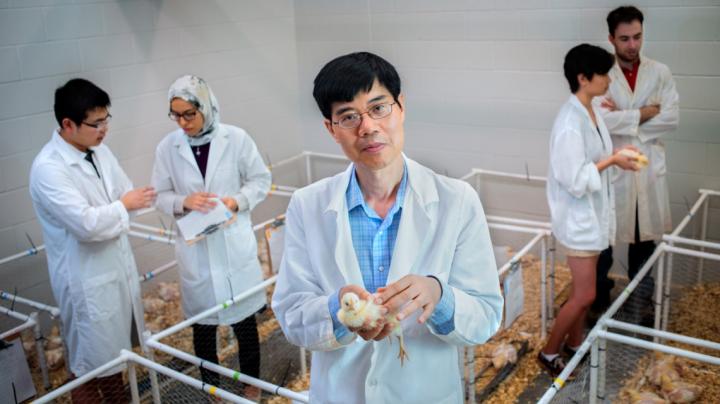
Credit: Robyn Wishna
ITHACA, N.Y. – Cornell University is co-leading a $9.95 million, five-year U.S. Department of Agriculture grant that aims to transform nutrition and water use in the poultry industry in order to improve its environmental impact and enhance human health.
The grant, awarded by the National Institute of Food and Agriculture on Sept. 1 and co-led by the University of Arkansas, is among the largest grants ever awarded by the USDA, and dovetails with Cornell’s land-grant missions of research, extension and teaching, said Xingen Lei, professor in the Department of Animal Science in the College of Agriculture and Life Sciences and co-principal investigator.
“Poultry is a major animal source of protein to Americans, so it will be a great opportunity for us to improve production efficiency, quality of the meat and economic returns with added values for the producers,” Lei said. “It’s an effective way for us to make an impact.”
One of the projects Lei will lead involves using microalgae as an alternative feed protein. “What we want to do in this case is use microalgae to replace soybeans – this will reduce the competition between feed and food,” he said. “Also, microalgae capture carbon dioxide from the atmosphere, and this will make production greener.”
Lei said his lab has already made strides working with algae as a protein-rich food source. However, algae are expensive compared with soybean meal, the current source of protein in commercial poultry diets. His goal is to improve the nutritional quality and the environmental value of the feed while making it more affordable and practical for farmers to use.
Through microalgae, researchers can introduce enzymes that favor unsaturated fatty acids and vitamin D. In collaboration with Kimberly O’ Brien, professor in the Division of Nutritional Sciences in the College of Human Ecology, Lei will look for ways to improve the chickens’ overall health and, by extension, the consumers’ health.
O’Brien said she will lead studies at the Human Metabolic Research Unit, investigating potential biological benefits for humans who eat bioenhanced poultry.
Researchers at the University of Arkansas will be developing ways to improve chickens’ gut health and resistance to disease, in addition to exploring how the industry can use water more efficiently.
One of the grant’s sustainability components also involves a collaboration between Cornell researchers Jefferson Tester, professor in the Smith School of Chemical and Biomolecular Engineering, and Johannes Lehmann, the Liberty Hyde Bailey Professor of soil and crop sciences in the School of Integrated Plant Science.
The researchers will process poultry manure and other food waste sources in order to produce energy in the form of biogas, bio-oil, electricity and biochar. Through techniques such as hydrothermal liquefaction and pyrolysis, they can recycle carbon and nutrients in cost-effective, environmentally sustainable ways.
“We are interested in developing methods for producing both energy and recovering nutrients,” said Tester, who co-teaches a class called Global Food, Energy, and Water Nexus for a Sustainable Future with Lei, Miller and Prabhu Pingali, professor in the Charles H. Dyson School of Applied Economics and Management.
“We’ve all been working on innovations, and through this grant we can bring all of those together in ways that haven’t been attempted before,” said Walter Bottje, a poultry science faculty member at the University of Arkansas and co-principal investigator for the grant. “We are hopeful that some of what we do will have global implications.”
Other participating Cornell faculty include: Pingali; Dennis Miller, professor of food science and nutrition; Fengqi You, the Roxanne E. and Michael J. Zak Professor, Smith School of Chemical and Biomolecular Engineering; Beth Ahner, professor in the Department of Biological and Environmental Engineering and senior associate dean in CALS; and Charles Greene, professor in the Department of Earth and Atmospheric Sciences. The team also includes Lei’s collaborators on microalgae research, Zackary Johnson of Duke University and Colin Beal of B&D Engineering and Consulting.
The University of Arkansas, Pine Bluff; Mississippi State University; and Iowa State University are also collaborating on the grant.
Cornell University has dedicated television and audio studios available for media interviews supporting full HD, ISDN and web-based platforms.
-30-
###
Media Contact
Lindsey Hadlock
[email protected]
607-269-6911
Original Source
http://news.




